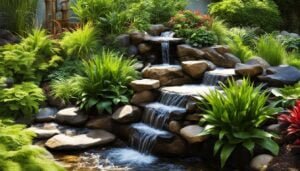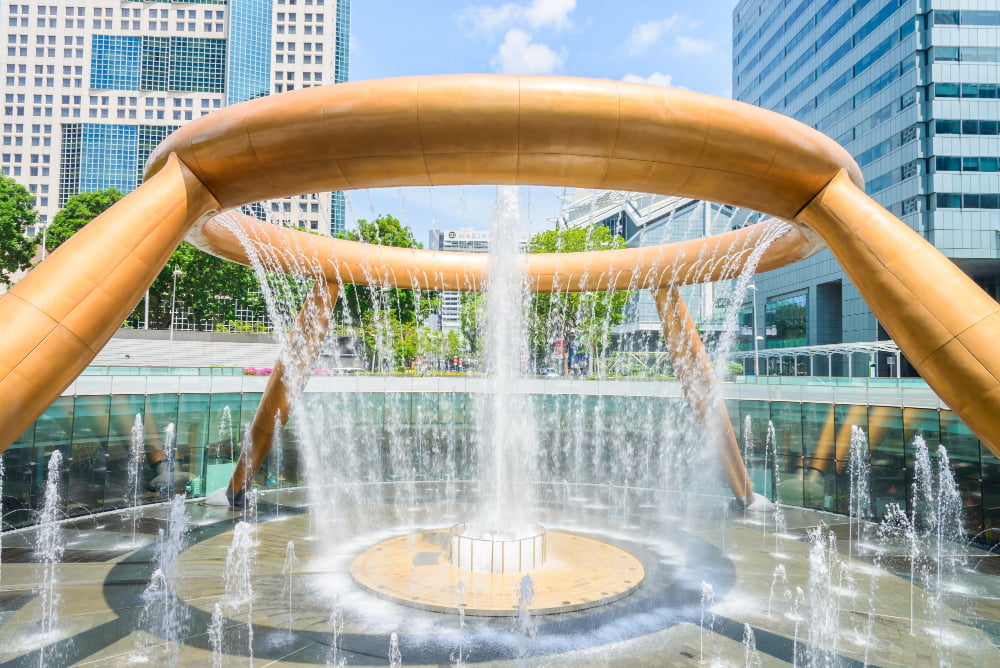Eco-friendly water features not only add beauty to a space but also contribute to sustainable urban gardening and eco-friendly landscape design. By incorporating innovative water conservation techniques, these water features can create a harmonious balance between human needs and environmental responsibility.
With the growing emphasis on sustainability, eco-friendly water features have become an essential element of landscape design. These features are designed to minimize their impact on the environment while maximizing their aesthetic appeal.
Sustainable urban gardening focuses on using natural resources efficiently and reducing waste. Eco-friendly water features play a significant role in achieving these goals. By incorporating innovative water conservation techniques, such as rainwater harvesting and native plant integration, these features can help conserve water resources and create wildlife habitat gardens.
Furthermore, eco-friendly water features embrace the principles of eco-friendly landscape design by utilizing materials and design strategies that minimize environmental impact. These features are designed to blend seamlessly with the natural surroundings, creating a visually appealing and sustainable landscape.
Overall, eco-friendly water features offer a range of benefits, from enhancing the beauty of outdoor spaces to promoting sustainable practices. By incorporating these features into landscape design, individuals can create stunning outdoor environments that contribute to a healthier planet.
Key Takeaways:
- Eco-friendly water features contribute to sustainable urban gardening and eco-friendly landscape design
- Innovative water conservation techniques can be incorporated into these features
- Rainwater harvesting and native plant integration help conserve water resources and create wildlife habitat gardens
- Eco-friendly water features embrace the principles of eco-friendly landscape design
- These features offer a range of benefits for outdoor spaces and the environment
Rainwater Harvesting and Native Plant Integration
One of the key aspects of creating eco-friendly water features is rainwater harvesting. This sustainable practice involves collecting rainwater and utilizing it in place of traditional freshwater sources. By implementing rainwater harvesting systems in eco-gardens, we can significantly reduce our reliance on precious water resources and contribute to a greener future.
Rainwater harvesting not only promotes water conservation but also supports the creation of wildlife habitat gardens. These gardens play a vital role in preserving biodiversity and providing a safe haven for local wildlife populations. By integrating native plants into the design of water features, we can establish an ecosystem that fosters ecological balance and encourages the thriving of various species.
Native plants are well-adapted to the local environment and provide essential resources, such as food and shelter, for indigenous wildlife. They attract pollinators like bees and butterflies, contributing to the overall health of the ecosystem. In addition, the use of native plants helps to reduce the need for fertilizers and pesticides, further enhancing the eco-friendliness of the garden.
By combining rainwater harvesting with the integration of native plants, eco-gardens can become vibrant wildlife habitat gardens, creating a harmonious space that supports local biodiversity and conserves water resources.
Solar Power: A Game Changer for Fountains

The integration of solar power in fountain design revolutionizes the concept of eco-friendly water features. By utilizing solar energy, these fountains operate without electricity, reducing carbon emissions and minimizing their environmental impact. This aligns with the principles of high-tech smart gardening and space-efficient vertical gardening, creating a sustainable solution for urban environments.
Implementing solar-powered fountains offers numerous benefits. Firstly, it reduces dependency on traditional power sources, making it a cost-effective and environmentally friendly choice. Secondly, the integration of solar panels on the fountain’s surface ensures a self-sustaining system that operates independently. This makes it a perfect fit for space-efficient vertical gardening, where every square inch matters.
Advantages of Solar-Powered Fountains:
- Significantly reduces electricity consumption and carbon footprint
- Provides a self-sustainable water feature that operates independently
- Aligns with the principles of high-tech smart gardening
- Space-efficient and ideal for vertical gardening
- Visually appealing and adds a modern touch to any outdoor space
Additionally, solar-powered fountains offer versatility in terms of installation. They can be easily incorporated into various garden designs, including rooftop gardens, balconies, or even small apartments with limited outdoor space. This innovative approach enhances the aesthetic appeal of the garden while promoting sustainable living.
As the demand for eco-friendly and sustainable gardening practices increases, the integration of solar power in fountains plays a crucial role in preserving the environment and creating visually stunning landscapes. By utilizing the power of the sun, these water features become a symbol of contemporary garden artistry, combining functionality with the beauty of nature.
Sustainable Water Features in Urban Planning
Sustainable water features play a crucial role in urban planning, offering solutions to manage stormwater runoff and promote water conservation. By incorporating urban permaculture practices and creating green roof ecosystems, these features can enhance the sustainability of public spaces while adding aesthetic value. Additionally, integrating these water features with building cooling and geothermal systems helps regulate temperatures in a visually pleasing manner.
Urban permaculture practices involve designing and maintaining urban spaces in a way that mimics natural ecosystems, promoting sustainability and resilience. By incorporating these practices into water feature design, cities can create functional and beautiful spaces that contribute to the overall well-being of both residents and the environment.
Green roof ecosystems, also known as living roofs, are vegetated roof systems that help reduce stormwater runoff, improve air quality, and regulate building temperatures. These ecosystems can be designed to incorporate sustainable water features, such as rain gardens or bio-ponds, which not only provide habitat for plants and animals but also serve as natural water filters.
When integrated with building cooling and geothermal systems, sustainable water features can help regulate temperatures in urban areas. For example, water cascading down a green wall or flowing through a rooftop bio-pond can provide evaporative cooling, reducing the need for energy-intensive air conditioning systems.
By combining urban permaculture practices, green roof ecosystems, and innovative water feature design, urban planners can create sustainable and visually engaging public spaces that benefit both the community and the environment.
Inspiring examples of sustainable water features in urban planning include:
In Chicago, Millennium Park serves as a 24.5-acre urban oasis that includes the iconic Cloud Gate sculpture and a sustainable water feature known as the Crown Fountain. This fountain uses innovative water recirculation technology to conserve water while providing an interactive experience for visitors.
In Singapore, the Gardens by the Bay is an award-winning garden that showcases a series of sustainable water features, including the iconic Supertree Grove. These features are equipped with integrated rainwater collection systems that recycle water for irrigation, reducing reliance on freshwater sources.
In Portland, the community-led Living Water Garden has transformed a former landfill into a nature park. This site features sustainable water elements such as wetlands, rain gardens, and bioswales that manage stormwater runoff and enhance water quality.
These examples demonstrate how sustainable water features can be seamlessly integrated into urban environments, creating spaces that are not only visually appealing but also ecologically responsible.
Conclusion
Eco-friendly water features have become iconic representations of innovation and sustainability in contemporary garden artistry. By embracing technological advancements, such as smart garden automation and solar power, these features not only enhance the beauty of gardens but also promote eco-friendly practices. Incorporating biophilic design principles further strengthens the connection between humans and nature, creating harmonious spaces that benefit both the environment and human well-being.
One of the key sustainable solutions offered by eco-friendly water features is rainwater harvesting, which helps conserve water resources while reducing reliance on traditional sources. Additionally, by integrating organic composting methods, these features support eco-friendly garden renovation projects, providing nutrient-rich soil for plants and reducing waste. This holistic approach to gardening fosters a sense of environmental responsibility and encourages the use of eco-friendly practices.
Smart garden automation plays a significant role in the efficient maintenance of eco-friendly water features. With automated systems, the operation and management of fountains and water features can be easily monitored and controlled, reducing water waste and promoting sustainable water management practices. This, together with the integration of state-of-the-art technology, enhances the overall sustainability of contemporary gardens.
By combining the principles of contemporary garden artistry, such as biophilic design and eco-friendly garden renovation, these water features not only create visually stunning landscapes but also contribute to a more sustainable future. As we continue to prioritize the harmony between nature and human well-being, the use of eco-friendly water features will undoubtedly play a crucial role in shaping our urban environments to be more environmentally responsible and aesthetically pleasing.
Frequently Asked Questions
How can eco-friendly water features contribute to sustainable gardening practices?
Eco-friendly water features not only add beauty to a space but also contribute to sustainable gardening practices by incorporating innovative water conservation techniques and adopting eco-friendly landscape design. They help create a harmonious balance between human needs and environmental responsibility.
How can rainwater harvesting systems be integrated into eco-friendly water features?
Rainwater harvesting systems can be integrated into eco-friendly water features to conserve water by using collected rainwater instead of freshwater sources. This reduces reliance on traditional water sources and supports the creation of wildlife habitat gardens. Incorporating native plants into the design ensures an ecosystem that promotes ecological balance and supports local wildlife populations.
How does the integration of solar power revolutionize the concept of eco-friendly water features?
The integration of solar power in fountain design revolutionizes the concept of eco-friendly water features. By utilizing solar energy, these fountains operate without electricity, reducing carbon emissions and minimizing their environmental impact. This aligns with the principles of high-tech smart gardening and space-efficient vertical gardening, creating a sustainable solution for urban environments.
How do sustainable water features contribute to urban planning?
Sustainable water features play a crucial role in urban planning by offering solutions to manage stormwater runoff and promote water conservation. By incorporating urban permaculture practices and creating green roof ecosystems, these features enhance the sustainability of public spaces while adding aesthetic value. Additionally, integrating these water features with building cooling and geothermal systems helps regulate temperatures in a visually pleasing manner.
How do eco-friendly water features promote innovation and sustainability?
Eco-friendly water features have evolved into symbols of innovation and sustainability. By embracing technological advancements, such as solar power and smart garden automation, and incorporating biophilic design principles, these features enhance the beauty of contemporary gardens while promoting eco-friendly practices. They offer a range of sustainable solutions for garden renovation projects, from rainwater harvesting to the use of organic composting methods.










